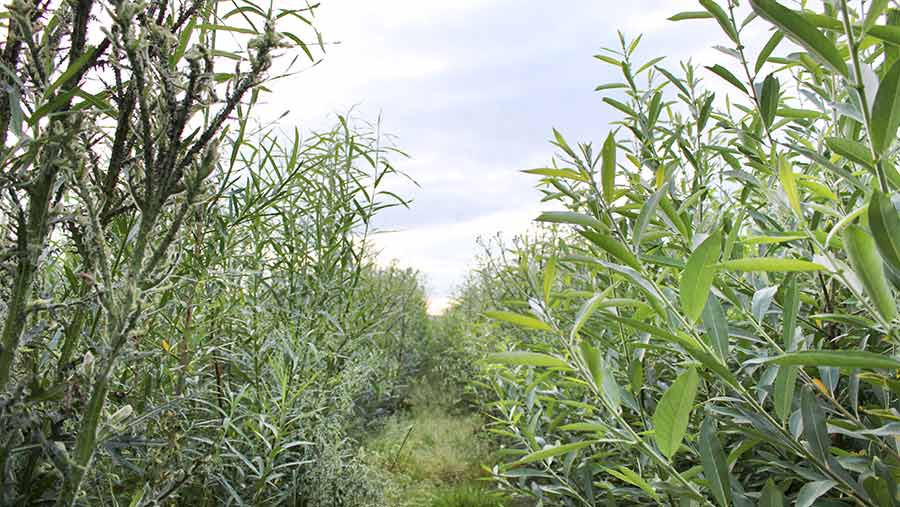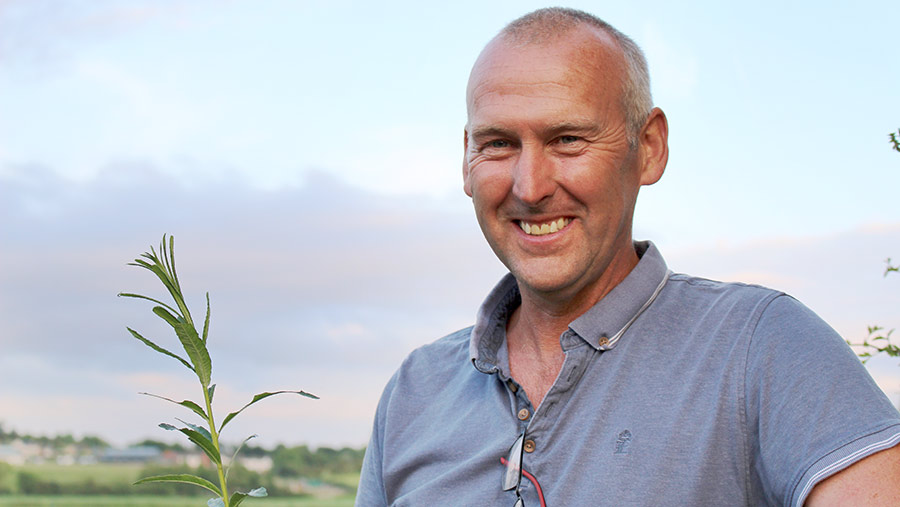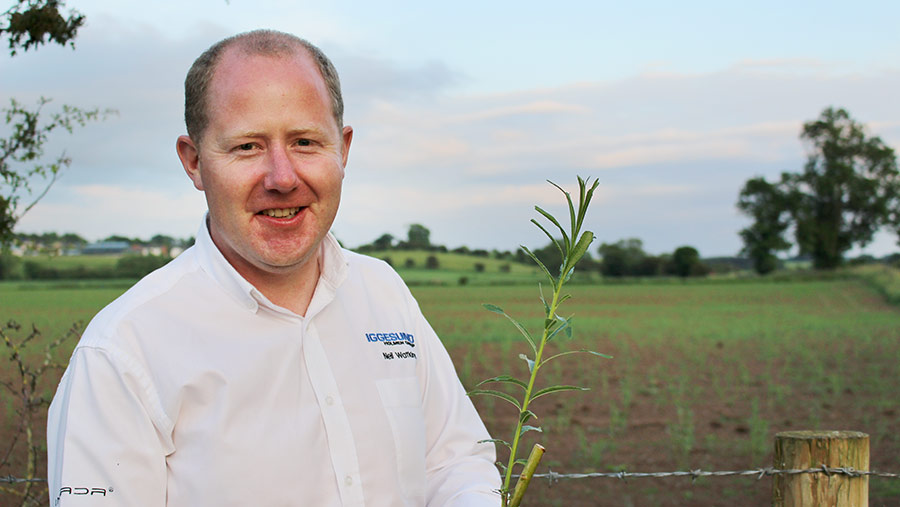How willow can reduce flood risk and earn farms £618/ha

Growing willow is a diversification option that can earn farmers up to £618/ha (£250/acre) a year and help protect land against flooding and soil erosion.
At Langwathby Hall Farm, near Penrith, Cumbria, farmer Simon Peet has been growing willow for a year and has planted over 16ha (40 acres) on his 100ha (250-acre) farm.
His land runs along one-and-a-quarter miles of the River Eden, which floods every year, meaning he is unable to grow crops or graze it during the winter.
See also: Video: How Gloucs farmers are working to prevent future flooding
During Storm Desmond in 2015, 6,000t of gravel was deposited on Mr Peet’s fields, with the damage to land and fences stretching to almost £40,000.
As a result, he looked into planting willow, which has been found to lessen the effects of flooding and reduce soil erosion.
Mr Peet says: “We are always looking at ways we can diversify our business and willow offered us an opportunity to earn some decent money on land that we can’t crop in the winter or graze with livestock. It has also been found to help stabilise the soil and slow the flood water, which reduces the damage.”
Working with paperboard manufacturer Iggesund Paperboard, Mr Peet last year planted 6ha (15 acres) followed by an additional 10ha (25 acres) this year, with a further 12ha (30 acres) to be planted next year.
Iggesund provides farmers with long-term contracts for growing willow to fuel its biomass boiler at Workington in Cumbria.

Simon Peet
Establishing willow
Planting willow is no different to planting any other crop. To establish willow, fields should be sprayed off with 5 litres/ha of round-up, ploughed and then power harrowed in the autumn, and a cover crop added before planting the willow in the following spring/early summer. The ideal soil pH should be between 6.5 and 7.
The cuttings are 20cm when they are planted. They are established in a twin-row format, meaning the machines used to harvest can go over the same tram lines, thus reducing soil compaction.
The aim is to produce 15,000 cuttings/ha. After the crops have been planted there is very little more that needs doing.
“Essentially you can just shut the gate and leave the willow crops for three years,” Mr Peet told farmers at a meeting organised by the Cumbria Farmers Network earlier this month (12 June).
It cost him £1,200/ha to establish, with returns expected to be about £618/ha (£250/acre) a year depending on acreage grown, yields and distance to the mill.
Once willow is established, it is harvested every three years, with the life expectancy of a willow plant expected to be 25+ years. If the land floods, harvest can be rolled over to the following year at no loss to the grower.
Varieties
A mixture of 6-8 varieties of willow are used, but it’s mainly willow shrub hybrids that are planted.
Iggesund’s alternative fuels manager Neil Watkins explains: “We only use varieties that have no known disease and have been thoroughly trialled and tested with performance test data to back them up.
“Their tapping roots spread sideways rather than down, which provides a good matting, keeping the soil together and not causing any destruction to drains.”
Mr Watkins describes willow as the UK’s equivalent of bamboo. “It’s fast growing and high yielding with expected yields of 9-14 oven-dried tonnes (ODT) a year.
It can grow on even some of the poorest land or good land and is a very low input crop,” he says.
Mr Peet says even though the oldest willow crop on his farm is only one year old he has already seen the benefit of reducing the flood damage.
“Normally when the River Eden floods we lose some fences. This year when it flooded, one of the fences that always goes didn’t, so it must be doing something,” he says.

Neil Watkins
Contracts
Mr Peet is contracted to sell the willow to Iggesund, which supports him throughout the process. The farmers buy the cuttings with help from Iggesund, which covers the cost and organises the harvest and haulage.
“We have special machines that can harvest willow. Rather than using a middleman to harvest and transport the crop, we deal with the farmers directly, so everything is transparent,” says Mr Watkins.
The crop is chipped straight away when it is harvested and transported to the biomass plant rather than being cut whole and then stored on the farm. Growers are paid per green tonnage.
Willow and sheep
Trials at Iggesund’s own willow plantation in Workington, where sheep graze in between the willow, has seen some success, explains Mr Watkins.
“Over the year before harvest we’ve had 20 ewes with twins grazing among the crop. The sheep grazed it cleanly without damaging the willow. It also offered protection to them when it was cold and windy and was a good shelter for the lambs,” he says.
The benefits of willow
Not only can willow provide farmers with an income on land that may not have returned a penny, there are plenty of other benefits:
- Horizontal growing roots help reduce soil erosion and improve soil infiltration
- Can generate income from poor quality land, so is a good diversification option
- Grows in most UK soil types and climates
- Improves local air quality
- Provides natural flood management as it slows the water (hydronic roughness)
- Can be used as biosecurity barriers
- Provides shelterbelts and windbreaks in winter for large arable growers or livestock
- Early pollination sites for bees (good mix with arable crops)
- Minimal input needed to maintain crop
- Potential to graze lowland sheep and Mules in year three of harvest crop. Worm risk will be low as land will be clean as not grazed for two previous years.
- Eligible for Single Farm Payment as it’s considered a greening crop
Did you know?
One hectare of willow wood chip has the same energy content as 4,500l of home heating oil. It will also yield at least 14 to 30 times more energy than is needed for its production.
How does willow help reduce flooding?
The Environment Agency has described the function of willow plantations in their use for flood management like a ‘green leaky dam’, used to slow the speed of water across the floodplain.
Willow has the highest ability to increase hydronic roughness, which means a willow plantation slows water down from entering watercourses for longer and catches sediment.
Floodplains comprised of entirely short grazed grassland do not provide much roughness and it’s the roughness – whether it’s willow, large boulders, trees, walls or hedges – that slows the speed of water as it flows over the floodplain.
This means it can also reduce the amount of debris the flood water carries.
